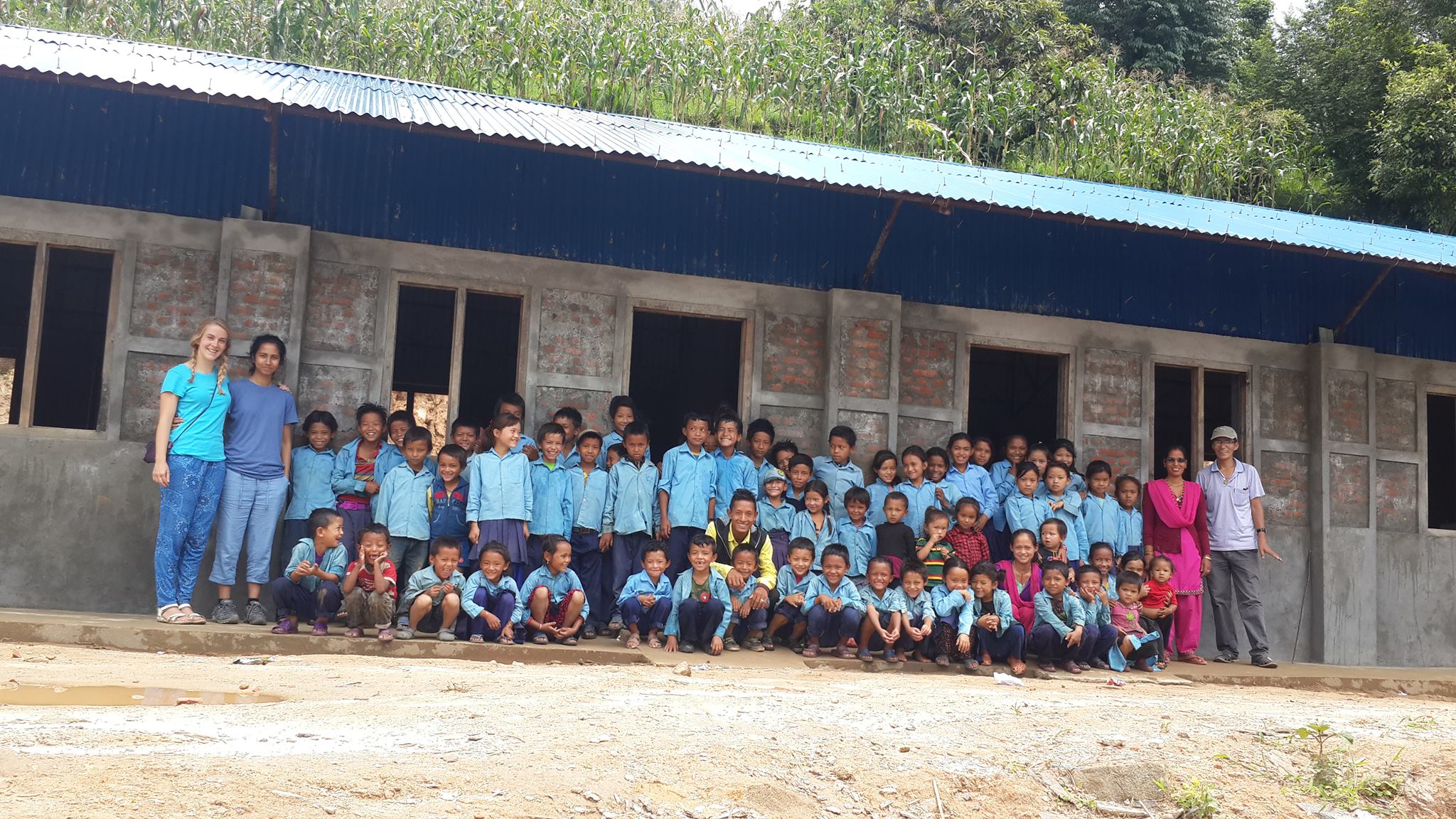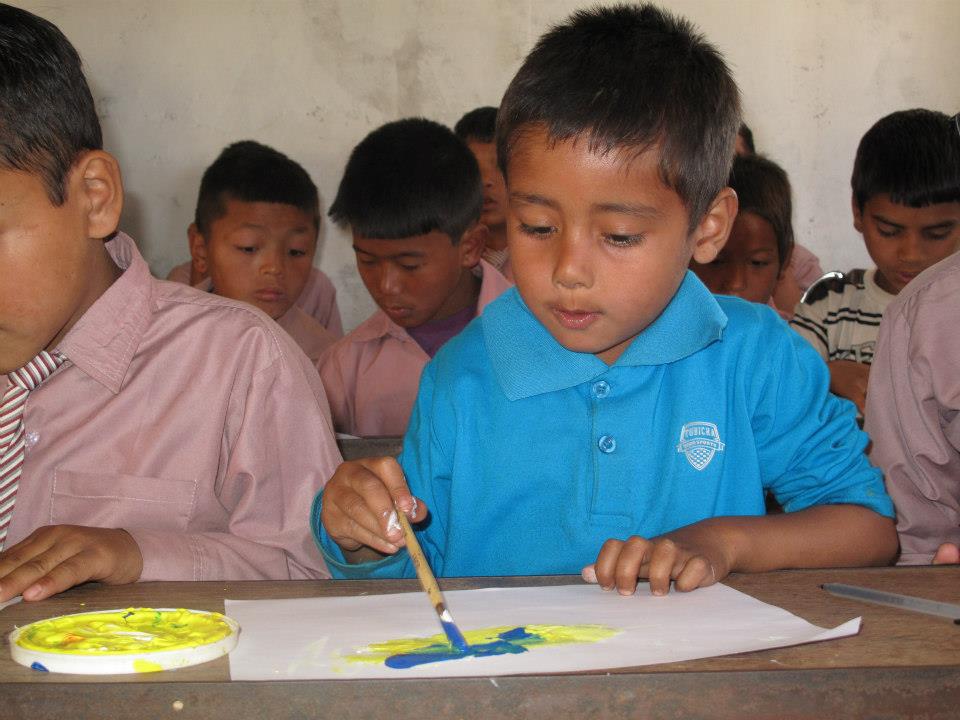
- Uniforms (1000)
- School Bags (100)
- Research Materials (100)
- Books (1122)
Shree Satdhara Basic School offers education for students from grade one to six and has students attending school aged from 3- 14. The school has total number of 88 students according to admission record of 2073 among which 43 are female and 45 are male students. Five teachers- 2 supported by the government, 1 sponsored by Mondo/HELP, with the remaining managed through contributions from the community are currently appointed at the school.
The April/May 2015 earthquake destructed all the classrooms at the school. HELP, however, has already rebuilt three classrooms (15x16) within a year and classes have already begun. The people in the village place high value in education, which can be reflected in many students attending the school with lot of energy and enthusiasm and their keenness to learn in their classrooms, despite poverty and scarcity.
You will be expected to teach from 10 AM to 4 PM with an hour of lunch break in between and each subject period lasts for 45 minutes.
NOTE: Following the devastating earthquakes in April and May in 2015, several of our partner schools including Shree Saatdhaara suffered major damage, which destroyed much of its infrastructure including classrooms, toilets and the playground, as well vital educational resources such as whiteboards, desks and benches. As quickly as possible after the quakes, we helped to build over 225 temporary classrooms across 45 schools of which Saatdhaara is one of them. The children were studying in the TLC before the inauguration of three newly constructed classrooms by HELP's support.
Saathdhaara is one of the 15 schools HELP has signed an MoU with Department of Education and HELP is currently working on fundraisings to help build permanent classroom building for the school.
Subjects taught:
Classes are run in English medium from nursery to class 4 and class 6 run in Nepali medium
- Science- basic ideas like living and non-living things, plants, etc. in junior classes while textbooks in senior classes have physics, chemistry, biology and astronomy lessons.
- English- stories, poems, biography and similar texts and grammar
- Social Studies- society- the issues and proposed solutions, geography, history, organizations
- Nepali- stories, poems, biographies, Nepali grammar and similar texts
HELP Partner School Fact Files: Bhirkharka
Email: info@help-nepal.org
Tel: 977 01 5210376
URL: www.help-nepal.org
Students’ Level of English Comprehension
Senior Classes (Grade 4 and above) :
Reading - Very few students can read the texts in their books but understanding of the texts is very limited.
Writing - Only a handful of students can manage to write some of the simplest English sentences but those they can write are mostly memorized ones from their textbooks, so actual understanding is fairly limited.
Speaking - Only very few students can communicate with volunteers; but in higher classes students are less shy and they very much enjoy talking to volunteers.
Junior Classes (Grades 3 and lower) :
Reading - very few can read their textbooks with frequent pauses
Writing - Only very few can write simplest forms of correct sentences but mostly memorized ones from the books so understanding is fairly limited.
Speaking - Very limited, but students manage to communicate once they become more confident.
Teacher’s level of English: Only two of the teachers can manage to communicate with the volunteers, but they enjoy trying to speak in English. Speaking to them can be a huge encouragement for the teachers to try to speak in English and improve it in the process.
Exams: Teachers devise questions mostly comprising exercises from the textbooks. They have simple monthly tests and more important exams every 4 months.
Resources available :
- Colours and drawing papers available; but in limited stock so needs constant replacment.
- Colours and drawing papers available; but in limited stock so needs constant replacment.
- Extra-curricular resources: The playground is right next to the school. The outdoor games that can be played include, badminton, softball. Badminton, rings and skipping are popular sports among the girls.
- All classrooms have whiteboards.
- How to teach effectively: The school owns a textbook for each school subject. You can copy a list of topics from the textbooks that you feel you would like to teach using the materials you have brought and/or the techniques you have acquired and teach in your own way. This will give the local teachers an idea of how to teach rest of the chapters in the book in an interactive way. You can be an inspiration for the local teachers. It is best if you plan your lessons with the local teachers during the evenings and teach together. While your new interactive methods can give ideas for local teachers to teach effectively, local teachers can help you understand the context of the village, children and schooling in general.
- The children love doing homework, so keep giving them some creative homework that summarises your lesson and the kind they can complete in the limited study time they have at home. Try encouraging the students to take benefit of their environment through activities such as herbarium, collection of wild fruits and flowers, etc. You can bring stickers that you can paste to the exercise books of students who do the best homework and class work to encourage them to do better, further; and to encourage others to get the stickers. This really excites the students and the class environment hence inspiring them to be keen for the lessons while being disciplined.
- Things that could make teaching easier for you: Card games for improving vocabulary and to teach sentence structures, teaching aids to help teach pronunciation (as most of the teachers learnt English pronunciation in a wrong way, the children learn it wrong as well. It is a wonderful opportunity for you to keep/make the children’s basics of English up to date). White board markers would also be useful.
- Extra-curricular resources: The playground is right next to the school. The outdoor games that can be played include, badminton, softball. Badminton, rings and skipping are popular sports among the girls.
- All classrooms have whiteboards.
- How to teach effectively: The school owns a textbook for each school subject. You can copy a list of topics from the textbooks that you feel you would like to teach using the materials you have brought and/or the techniques you have acquired and teach in your own way. This will give the local teachers an idea of how to teach rest of the chapters in the book in an interactive way. You can be an inspiration for the local teachers. It is best if you plan your lessons with the local teachers during the evenings and teach together. While your new interactive methods can give ideas for local teachers to teach effectively, local teachers can help you understand the context of the village, children and schooling in general.
- The children love doing homework, so keep giving them some creative homework that summarises your lesson and the kind they can complete in the limited study time they have at home. Try encouraging the students to take benefit of their environment through activities such as herbarium, collection of wild fruits and flowers, etc. You can bring stickers that you can paste to the exercise books of students who do the best homework and class work to encourage them to do better, further; and to encourage others to get the stickers. This really excites the students and the class environment hence inspiring them to be keen for the lessons while being disciplined.
- Things that could make teaching easier for you: Card games for improving vocabulary and to teach sentence structures, teaching aids to help teach pronunciation (as most of the teachers learnt English pronunciation in a wrong way, the children learn it wrong as well. It is a wonderful opportunity for you to keep/make the children’s basics of English up to date). White board markers would also be useful.
HELP Partner School Fact Files: Bhirkharka
Email: info@help-nepal.org
Tel: 977 01 5210376
URL: www.help-nepal.org
Bhirkharka Village
Location:
Bhirkharka village can be reached after 3 hours uphill walk during the monsoon from Chanaute, a local town that lies along the Kathmandu-Helambu road. One can reach Chanaute after around 4-5 hours drive on a bus from Kathmandu. However, during the dry season, it might be possible to get to Bhirkharka directly on a jeep (5 hours drive) on a newly extended road from Chanaute. The village has a rainy summer (JUN-AUG), quite a cold winter (DEC-FEB) and boasts of warm sunny days in the remaining months. The village has sporadic electric power supply.
Accommodation :
Volunteers stay with a host family close to the school in a private room to be shared with other volunteer/s who teach (volunteer) together. There is a communal tap outside the house for washing clothes/ showering and a squat toilet outside the main house. You will often see a lot of children around, who love to come and join you in the mornings and evenings, playing and chatting. The host family will provide three meals a day, typically consisting of rice, lentils and some sort of curry.
The People:
The village is mainly inhabited by the people from Tamang community, whose ancestral history can be traced back to Tibet and represented by the presence of stupas, monuments and Buddhist flags around the village. There are roughly 150 houses situated on a terraced hill around 1900m in altitude and the village has a total population of around 1500. The main occupation of the villagers is farming and they mainly grow crops like maize, millet, beans and some potatoes in their farms situated at higher altitudes.
Although economic backward, the people there have a rich cultural heritage and they love to share their hospitality, which one can experience by attending one of the occasional village festivals or by visiting their homes when invited.
Major things to do:
- Visit Dhundeni School in the adjacent village- around 30 minutes gradual downhill walk on a newly extended road.
- Visit Chanaute- 2 hours downhill walk and meet fellow volunteers across HELP partner schools- Churetar, Ichowk, Dhundeni and Bhumeshwori.
- Visit Sermathang village- around 4 hours walk from the village that offers magnificent views of some of the Himalayan peaks. Along the enjoyable way to the village lies a huge golden statue of Guru Rinpoche on the top of the hill.
- Hike to Kakani, a touristic spot that offers very good view of some of the Himalayan peaks and Kajhe, Hyolmo village close to Kakani.
- Visit Palchok temple- one of the most famous Hindu temples in the region- around 3 hours walk across.
Past volunteers :
Yi Ren Thing: yirenthng@gmail.com
Lee Jia Wie: jiawei.lee.91@gmail.com
What/How HELP-Mondo has supported Bhirkharka?
Bhirkharka was among the first batch of schools HELP selected in 2010 and since then the community has remained very actively supportive to the ideas of improving education quality. In all the works we have done so far, the villagers have made encouraging contributions which we believe is important for sustainability and long term development of the school.
HELP Partner School Fact Files: Bhirkharka
Email: info@help-nepal.org
Tel: 977 01 5210376
URL: www.help-nepal.org
Prior to earthquake:
- Three new classrooms that have been built as per government standards of safety (post quake).
- 1 additional teacher and part of the salary of another.
- Drinking water supply and toilet facility management.
- Mini library facility.
- Music and sports equipment.
- Classroom management including desks and benches, whiteboards and notice boards.
- Textbook support.
- Gabion wall to support the base of the playground.
Post earthquake:
- Construction of three new classrooms built as per earthquake safety guidelines.
- Temporary Learning Centre construction.
- Fleece distribution under winterisation programme.
Contact person for Bhirkharka
Principal
Som Joti: 9808009151
- Needs
- Facts
- Performance at key stage 4 in 2016
- Temporary Learning Centre


